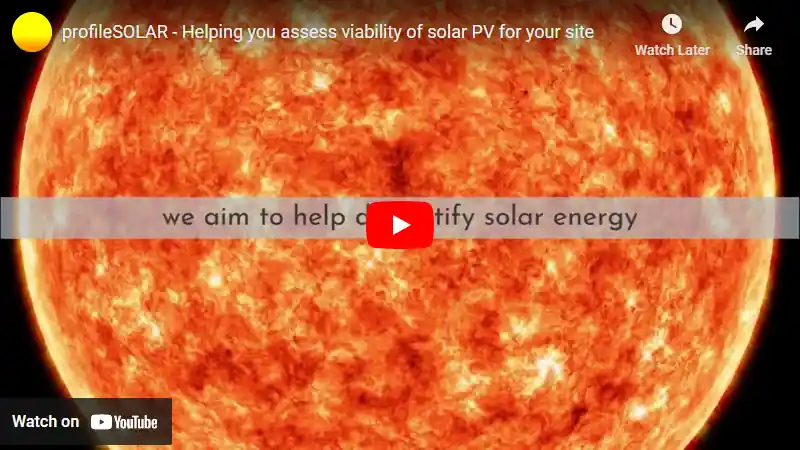

Bishop Auckland, located in County Durham, England, presents a mixed picture for solar PV energy generation. Situated in the Northern Temperate Zone, this location experiences significant seasonal variations in solar output, which impacts its overall suitability for year-round solar energy production.
Seasonal Solar Performance
The solar energy output at Bishop Auckland varies dramatically throughout the year. Summer months are the most productive, with an average daily output of 4.99kWh per kW of installed solar capacity. Spring follows closely behind, generating 4.28kWh/day. However, autumn sees a significant drop to 1.94kWh/day, while winter performance plummets to a mere 0.86kWh/day.
These figures indicate that solar PV systems in Bishop Auckland are most effective from late spring through early autumn. The long summer days in this northern latitude contribute to the high summer output, making it an ideal time for solar energy generation.
Optimal Panel Installation
To maximize year-round solar production in Bishop Auckland, fixed solar panels should be installed at a tilt angle of 46 degrees facing south. This angle optimizes the panels' exposure to sunlight throughout the year, accounting for the location's latitude and the Earth's elliptical orbit.
Environmental and Weather Factors
Several factors can impede solar production in Bishop Auckland:
- Cloud cover: The region experiences frequent overcast conditions, particularly in autumn and winter, reducing solar irradiance.
- Rainfall: Bishop Auckland receives significant rainfall throughout the year, which can affect panel efficiency.
- Short winter days: The location's northern latitude results in very short days during winter, severely limiting solar generation potential.
Mitigation Strategies
To enhance solar energy production despite these challenges, consider the following measures:
- Use high-efficiency solar panels designed for low-light conditions.
- Implement a robust cleaning schedule to combat the effects of rainfall and potential debris.
- Consider a hybrid system combining solar with other renewable sources to compensate for low winter production.
- Utilize solar tracking systems to maximize exposure during short winter days, although this may not be cost-effective for all installations.
While Bishop Auckland's location presents challenges for year-round solar energy production, careful planning and appropriate technology can still make solar PV a viable option, particularly during the more favorable months of the year.
Note: The Northern Temperate Zone extends from 35° latitude North up to 66.5° latitude.
So far, we have conducted calculations to evaluate the solar photovoltaic (PV) potential in 768 locations across United Kingdom. This analysis provides insights into each city/location's potential for harnessing solar energy through PV installations.
Link: Solar PV potential in United Kingdom by location
Solar output per kW of installed solar PV by season in Bishop Auckland
Seasonal solar PV output for Latitude: 54.6519, Longitude: -1.6928 (Bishop Auckland, United Kingdom), based on our analysis of 8760 hourly intervals of solar and meteorological data (one whole year) retrieved for that set of coordinates/location from NASA POWER (The Prediction of Worldwide Energy Resources) API:




Ideally tilt fixed solar panels 46° South in Bishop Auckland, United Kingdom
To maximize your solar PV system's energy output in Bishop Auckland, United Kingdom (Lat/Long 54.6519, -1.6928) throughout the year, you should tilt your panels at an angle of 46° South for fixed panel installations.
As the Earth revolves around the Sun each year, the maximum angle of elevation of the Sun varies by +/- 23.45 degrees from its equinox elevation angle for a particular latitude. Finding the exact optimal angle to maximise solar PV production throughout the year can be challenging, but with careful consideration of historical solar energy and meteorological data for a certain location, it can be done precisely.
We use our own calculation, which incorporates NASA solar and meteorological data for the exact Lat/Long coordinates, to determine the ideal tilt angle of a solar panel that will yield maximum annual solar output. We calculate the optimal angle for each day of the year, taking into account its contribution to the yearly total PV potential at that specific location.

Seasonally adjusted solar panel tilt angles for Bishop Auckland, United Kingdom
If you can adjust the tilt angle of your solar PV panels, please refer to the seasonal tilt angles below for optimal solar energy production in Bishop Auckland, United Kingdom. As mentioned earlier, for fixed-panel solar PV installations, it is optimal to maintain a 46° South tilt angle throughout the year.
| Overall Best Summer Angle | Overall Best Autumn Angle | Overall Best Winter Angle | Overall Best Spring Angle |
|---|---|---|---|
| 38° South in Summer | 57° South in Autumn | 68° South in Winter | 46° South in Spring |
Our recommendations take into account more than just latitude and Earth's position in its elliptical orbit around the Sun. We also incorporate historical solar and meteorological data from NASA's Prediction of Worldwide Energy Resources (POWER) API to assign a weight to each ideal angle for each day based on its historical contribution to overall solar PV potential during a specific season.
This approach allows us to provide much more accurate recommendations than relying solely on latitude, as it considers unique weather conditions in different locations sharing the same latitude worldwide.
Calculate solar panel row spacing in Bishop Auckland, United Kingdom
We've added a feature to calculate minimum solar panel row spacing by location. Enter your panel size and orientation below to get the minimum spacing in Bishop Auckland, United Kingdom.
Our calculation method
- Solar Position:
We determine the Sun's position on the Winter solstice using the location's latitude and solar declination. - Shadow Projection:
We calculate the shadow length cast by panels using trigonometry, considering panel tilt and the Sun's elevation angle. - Minimum Spacing:
We add the shadow length to the horizontal space occupied by tilted panels.
This approach ensures maximum space efficiency while avoiding shading during critical times, as the Winter solstice represents the worst-case scenario for shadow length.
Topography for solar PV around Bishop Auckland, United Kingdom
Bishop Auckland, located in County Durham in northeast England, sits within a diverse topographical landscape. The town itself is situated on a plateau overlooking the confluence of the River Wear and the River Gaunless. This elevated position offers sweeping views of the surrounding countryside, which is characterized by gently rolling hills and shallow valleys. To the west of Bishop Auckland, the terrain becomes more rugged as it transitions into the North Pennines. This area features steeper slopes, moorlands, and higher elevations. The eastern side of the town, in contrast, opens up into a broader, flatter landscape that stretches towards the coast. The River Wear meanders through the region, carving a picturesque valley that adds to the area's scenic beauty. This river valley, with its mix of wooded areas and open fields, contributes to the varied topography of the region.
Potential for Large-Scale Solar PV
When considering areas nearby that would be most suited to large-scale solar PV installations, several factors come into play. The ideal locations would have relatively flat or gently sloping terrain, good exposure to sunlight, and minimal shading from hills or trees. The areas to the east and southeast of Bishop Auckland show the most promise for solar PV development. These regions feature more expansive, open landscapes with fewer steep slopes compared to the western parts. The flatter terrain here would make it easier and more cost-effective to install large arrays of solar panels. Specifically, the agricultural lands between Bishop Auckland and Darlington could be potential sites for solar farms. These areas offer large, uninterrupted spaces with good solar exposure. Similarly, the open fields to the south, towards Shildon and Newton Aycliffe, might also be suitable for large-scale solar installations. However, it's important to note that any solar PV development would need to balance energy production goals with considerations for land use, environmental impact, and local planning regulations. The region's agricultural heritage and scenic value would need to be taken into account when identifying specific sites for solar farms. While the immediate vicinity of Bishop Auckland offers some potential for solar PV, larger scale projects might find more suitable conditions slightly further afield, where the landscape opens up into broader, flatter expanses that could accommodate extensive solar arrays while minimizing visual impact on the historic town and its surroundings.United Kingdom solar PV Stats as a country
United Kingdom ranks 14th in the world for cumulative solar PV capacity, with 13,689 total MW's of solar PV installed. This means that 4.00% of United Kingdom's total energy as a country comes from solar PV (that's 20th in the world). Each year United Kingdom is generating 203 Watts from solar PV per capita (United Kingdom ranks 25th in the world for solar PV Watts generated per capita). [source]
Are there incentives for businesses to install solar in United Kingdom?
Yes, there are several incentives for businesses wanting to install solar energy in the United Kingdom. The UK government offers a Feed-in Tariff (FiT) scheme which pays businesses for every unit of electricity they generate from their solar panels. Additionally, businesses may be eligible for tax reliefs such as Enhanced Capital Allowances and Renewable Heat Incentives. Finally, some local authorities offer grants or other financial support to help businesses with the cost of installing solar energy systems.
Do you have more up to date information than this on incentives towards solar PV projects in United Kingdom? Please reach out to us and help us keep this information current. Thanks!
Citation Guide
Article Details for Citation
Author: Aaron Robinson
Publisher: profileSOLAR.com
First Published: Tuesday 24th of December 2024
Last Updated: Sunday 2nd of February 2025
Tell Us About Your Work
We love seeing how our research helps others! If you've cited this article in your work, we'd be delighted to hear about it. Drop us a line via our Contact Us page or on X, to share where you've used our information - we may feature a link to your work on our site. This helps create a network of valuable resources for others in the solar energy community and helps us understand how our research is contributing to the field. Plus, we occasionally highlight exceptional works that reference our research on our social media channels.
Feeling generous?

Share this with your friends!


Compare this location to others worldwide for solar PV potential
The solar PV analyses available on our website, including this one, are offered as a free service to the global community. Our aim is to provide education and aid informed decision-making regarding solar PV installations.
However, please note that these analyses are general guidance and may not meet specific project requirements. For in-depth, tailored forecasts and analysis crucial for feasibility studies or when pursuing maximum ROI from your solar projects, feel free to contact us; we offer comprehensive consulting services expressly for this purpose.
Helping you assess viability of solar PV for your site
Calculate Your Optimal Solar Panel Tilt Angle: A Comprehensive Guide
Enhance your solar panel's performance with our in-depth guide. Determine the best tilt angle using hard data, debunk common misunderstandings, and gain insight into how your specific location affects solar energy production.







